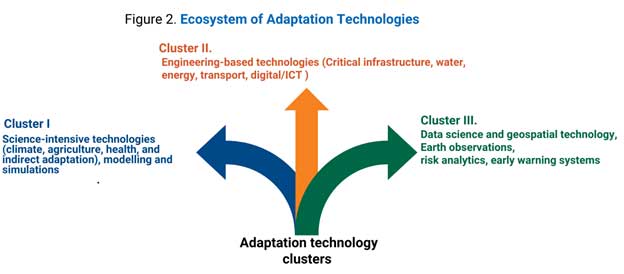Adaptation strategies demand a convergence of diverse approaches ranging from economic incentives and robust policy frameworks to locally driven interventions. Understanding the context of risk and vulnerabilities is fundamental to any policy response.
By Sanjay Srivastava, T N Singh, Praveen Kumar and Naina Tanwar
The summer of 2024 has shattered heat records, starkly illustrating the harsh realities of our warming planet. In India alone, the heatwave has claimed over 100 lives and caused more than 40,000 cases of heatstroke in recent months, according to data from India’s Health Ministry. This extreme weather event has further burdened the poor and vulnerable, exacerbating the social and economic toll of disasters.
‘A just transition’ in climate adaptation
While risk emanating from warming planet is global, adaptation is always local, and resilience is specific to the people, community and ecosystem. In the vulnerable context, an inclusive approach to climate change adaptation, emphasizing ‘a just transition’ is the way forward. India’s National Adaptation Communication to the United Nations Framework Convention to Climate Change (2023) underscores this strategic focus.
This commitment was further reflected by the significant increase in adaptation finance, with total adaptation expenditure reaching 5.6 per cent of the GDP in 2021-2022 growing from a share of 3.7 per cent in 2015-16.
Bihar case: Intersection of multi-dimensional poverty and climate risk
When extreme weather events intersect with multi-dimensional poverty, vulnerabilities already on threshold of tipping points reach closer to their limit. The state of Bihar in India exemplifies this challenge. NITI Aayog’s 2021 National Multidimensional Poverty Index (MPI) baseline report identifies Bihar as having the highest proportion of people who are multidimensionally poor.
The state also ranks lowest in India’s NITI Aayog’s SDG Index Report, with over 60 per cent of the districts classified as highly vulnerable. This disproportionate impact of disasters on the poor is evident in eastern parts of India, where the lowest MPI values of Bihar coincide with districts which are perennially prone to floods.
Bihar’s draft report on climate-resilient and low carbon development pathway (2024) emphasizes the need for resilient communities. Building resilient communities in vulnerable context requires adopting adaptation technologies backed by grassroots innovations and risk informed policy interventions.
Indian Institute of Technology Patna located in Bihar can play a crucial role in closing the state’s adaptation gap with advance technology, leading a just transition in adaptation and fostering collaborative solutions for equitable climate resilience A just transition approach built on adaptation tech applications in the multi-dimensional poverty context is key to its successful implementation.
Multi-pronged adaptation strategies
Adaptation strategies demand a convergence of diverse approaches ranging from economic incentives and robust policy frameworks to locally driven interventions. Understanding the context of risk and vulnerabilities is fundamental to any policy response. Monitoring and mapping are key to target at risk vulnerable communities to embark upon ‘a just transition’ adaptation policy.
The strategy has to move from sector to nexus approach to capitalize on inter- and cross sectoral linkages and synergies. This is important to avoid compound and cascading impacts across the sectors when disaster strikes. Adaptation technologies enable a ‘just transition’ pathways while addressing risk mapping and resilience building and responding to the climate extreme (Figure 1).

Key enablers: An adaptation technology cluster
Adaptation technologies comprise three clusters: (i) science-intensive, (ii) engineering-based and (iii) data science and risk analytics (Figure 2). Challenges lie in its customization and scaling up in specific context of vulnerabilities. ESCAP’s Risk and Resilience Portal, for example, synthesizes all three clusters and offers a unique capability to visualize current and future climate scenarios at baseline, 1.5 and 2 degrees.
This foresight is crucial for understanding the evolving risks of floods, droughts, heatwaves and tropical cyclones, allowing for anticipatory actions for early warning for the changing hazard landscape.

Opportunity for action: Operationalize adaptation technology cluster
At scale, India is operationalizing adaptation technologies to support ‘a just transition’ in vulnerable context. The Mahatma Gandhi National Employment Guarantee Act (MNREGA) with an annual budget of $13 billion (2020) addresses locale specific adaptation priorities.
Under MNREGA, assets are created across the country related to water harvesting, drought relief, flood control activities, and sanitation. Satellite derived Location based services are being utilized for planning and monitoring of nearly 7-8 million assets annually using mobile-based geo-tagging. The Online Geo-spatial maps with more than 30 million assets geotagged for all MGNREGA works across the country has been a game changer.
Scaling adaptation technology cluster has helped in policy execution for social empowerment of poor and vulnerable population with leak-proof public delivery systems. Utilizing the JAM Trinity (Jan Dhan, Aadhaar, Mobile), over $406.9 billion has been transferred to 11.67 billion beneficiaries. Real-time monitoring via geo-tagging enhances transparency and financial inclusion of poor and vulnerable through targeted policy schemes.
Further, start-up ecosystems are helping to scale adaptation technologies. For example, there are more than 2800 AgriTech start-ups in India driving innovation and transforming agriculture to adapt to climate risk situation. Having embraced Internet of Things (IoT) -enabled agricultural practices to now AI-enabled machines and tech, this burgeoning start-up ecosystem is quite promising. It is important to seize the moment of taking forward technological innovations to benefit India’s most vulnerable.
A dedicated centre for climate change adaptation technology is important to promote research, knowledge generation and capacity building in India’s most vulnerable context with focus on inclusion and climate justice.
Sanjay Srivastava is Chief of Disaster Risk Reduction Section, ESCAP; Professor T N Singh is Director, Indian Institute of Technology (IIT), Patna/India; Praveen Kumar is CEO (FIST-TBI), IIT Patna/India and Naina Tanwar is Consultant, Disaster Risk Reduction Section, ESCAP.
This piece has been sourced from Inter Press Service.
Image Credit: Pexels/Soubhagya Maharana

